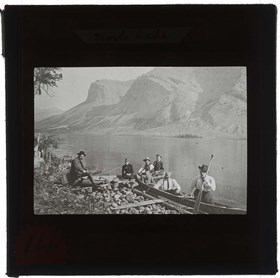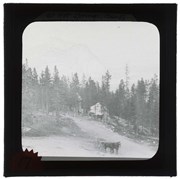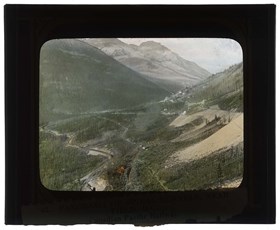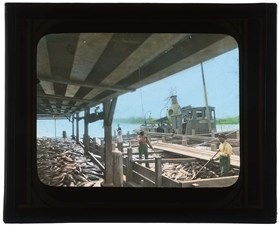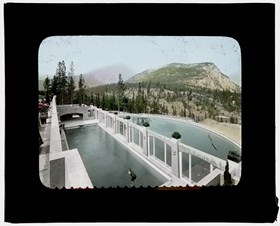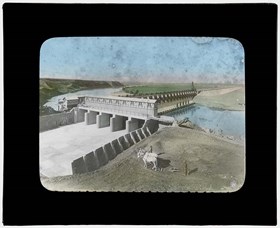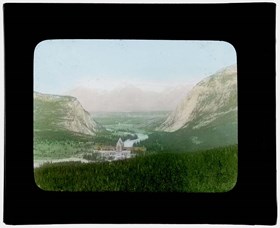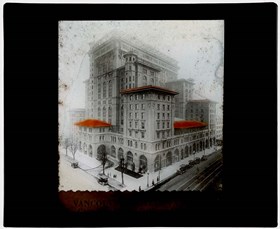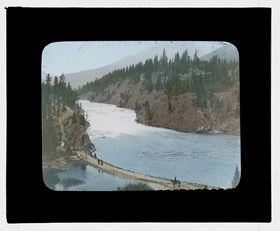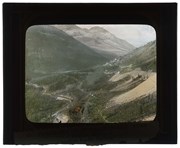Narrow Results By
- Canadian Pacific Railway fonds 4
- Chic Scott fonds 4
- Archives General File Collection
- Robert J. McGuinness fonds 2
- Ben Gadd fonds 1
- Bruce Hatfield fonds 1
- Charles Reid fonds 1
- Dorothy Wardle fonds 1
- Jean A. Hembroff MacDonald fonds 1
- Jon Whelan fonds 1
- Peter and Catharine Whyte fonds
- Trail Riders of the Canadian Rockies fonds 1
Banff Lantern Slides
https://archives.whyte.org/en/permalink/descriptions21760
- Part Of
- Archives General File Collection
- Scope & Content
- Series consists of 4 lantern slides. Slides are views of the Banff Hot Springs, Banff Avenue with Cascade Mountain, Devil's Lake, and the city of Calgary.
- Date Range
- [c. 1890]
- Reference Code
- V8 / 7919 / PS - 1 to PS - 4
- Description Level
- 3 / Series
- GMD
- Transparency
- Lantern slide
4 images
- Part Of
- Archives General File Collection
- Description Level
- 3 / Series
- Fonds Number
- M8 / V8 / S8
- Series
- Accession Number : 7919
- Sous-Fonds
- V8
- Accession Number
- 7919
- Reference Code
- V8 / 7919 / PS - 1 to PS - 4
- Date Range
- [c. 1890]
- Physical Description
- 4 photographs : b&w slides ; 8.2 x 8.2 cm
- Scope & Content
- Series consists of 4 lantern slides. Slides are views of the Banff Hot Springs, Banff Avenue with Cascade Mountain, Devil's Lake, and the city of Calgary.
- Subject Access
- Lantern slide
- Tourism
- Geographic Access
- Banff
- Calgary
- Alberta
- Canada
- Language
- English
- Conservation
- All slides were cleaned prior to scanning.
- Title Source
- Title based on contents of series
- Processing Status
- Processed
Images
This material is presented as originally created; it may contain outdated cultural descriptions and
potentially offensive content.
Read more.
Canadian Pacific Railway Lantern Slides
https://archives.whyte.org/en/permalink/descriptions16400
- Part Of
- Archives General File Collection
- Scope & Content
- Series consists of 14 lantern slides [ca.1900-ca.1925]. Slides are views along the Canadian Pacific Railway.
- Date Range
- [c. 1905]
- Reference Code
- V8 / 5486 / PS - 1 to PS - 14
- Description Level
- 3 / Series
- GMD
- Transparency
- Lantern slide
14 images
- Part Of
- Archives General File Collection
- Description Level
- 3 / Series
- Fonds Number
- M8 / V8 / S8
- Series
- Accession Number: 5486
- Sous-Fonds
- V8
- Accession Number
- 5486
- Reference Code
- V8 / 5486 / PS - 1 to PS - 14
- Date Range
- [c. 1905]
- Physical Description
- 14 photographs : b&w and col. slides ; 10.2 x 8.2 cm
- History / Biographical
- The Canadian Pacific Railway (CPR) was officially formed in Februray, 1881, to construct a railroad that would link the eastern provinces with British Columbia, a key component of the Canadian Confederation of 1867. Headed by William C. Van Horne as General Manager, the railroad arrived in the Canadian Rockies in 1883 and a siding was established just east of present-day Banff. When railroad workers discovered a natural hot spring on the south side of the Bow River, Van Horne ordered the construction of a hotel that would house visitors brought in by train to visit the springs. Construction of the Banff Springs Hotel finished in 1888 and joined a handful of CPR hotels throughout the Rocky and Selkirk Mountain ranges. The popularity of the hot springs and surrounding area led to the formation of a national park and to the town of Banff. After construction of the railway had completed, the CPR continued to survey and document the Rocky Mountains alongside federal agencies like the Department of the Interior and private outfitters. Utilizing coloured lantern slides the CPR was able to showcase the mountains as both tourist and settlement destinations. Magic lantern shows of these slides could be used for administrative purposes by the company to showcase land holdings and investments or in public shows as advertisements of the new railway.
- Scope & Content
- Series consists of 14 lantern slides [ca.1900-ca.1925]. Slides are views along the Canadian Pacific Railway.
- Name Access
- Canadian Pacific Railway
- Subject Access
- Lantern slide
- Education
- Tourism
- Travel and Exploration
- Trains
- Geographic Access
- Banff
- Lake Louise
- Alberta
- British Columbia
- Canada
- Language
- English
- Conservation
- All slides were cleaned prior to scanning.
- Creator
- Canadian Pacific Railway
- Biographical Source Notes
- https://cpconnectingcanada.ca/#building-the-railway
- Title Source
- Title based on contents of series
- Processing Status
- Processed
Images
This material is presented as originally created; it may contain outdated cultural descriptions and
potentially offensive content.
Read more.
Peter Whyte papers and photographs
https://archives.whyte.org/en/permalink/descriptions828
- Part Of
- Peter and Catharine Whyte fonds
- Scope & Content
- Series consists of the following sub-series: 1. Personal papers, 1905-1956; 2. Correspondence, 1909-1962; 3. Financial, legal and business papers, 1914-1964; 4. Professional activities and interests, 1920-1961; 5. Photographs, ca.1900-1930. Textual records pertain to Whyte's interests, influences a…
- Date Range
- 1905-1964
- Reference Code
- M36 / S37 / V683 / I / B
- Description Level
- 3 / Series
- Part Of
- Peter and Catharine Whyte fonds
- Description Level
- 3 / Series
- Fonds Number
- M36 / V683 / S37
- Series
- I.B. Peter Whyte papers and photographs series
- Accession Number
- 3069
- Reference Code
- M36 / S37 / V683 / I / B
- Date Range
- 1905-1964
- Physical Description
- 73 cm of textual records. -- ca.3400 photographs (ca.2000 prints, ca.1400 negatives, 3 albums of ca.300 prints).
- History / Biographical
- Peter Whyte, 1905-1966, was an artist, photographer, outdoor enthusiast, traveller and philanthropist at Banff, Alberta. Born in Banff, Alberta to pioneer Banff merchant Dave White and Annie (Curren) White, Peter Whyte took advantage of the many opportunities for winter sports afforded by the mountains, becoming an accomplished skier and ski jumper. He was one of the region's first native-born painters with an intimate knowledge of the mountains. Whyte studied cartooning by correspondence and was encouraged by resident and visiting artists to pursue an art career, first at the Otis Art Institute, Los Angeles, 1923-1924, and in 1925 at the School of the Museum of Fine Arts, Boston where he met Catharine Robb.
- Peter Whyte's varied activities included driving Hollywood stars to mountain motion picture locations, escorting groups of Chinese workers for the Canadian Pacific Railway, painting with Belmore Browne and J. E. H. MacDonald and travelling around the world by steamer. Following his marriage to Catharine, their painting flourished and their involvement in early ski development at Skoki occupied their winters. The accidental death of one of their ski guests had a profound effect on Pete and they left the ski business to travel.
- During the war, Whyte seved in the reserve army, Banff Company of the Calgary Highlanders and later with the Royal Canadian Air Force as a photographer. He served briefly as an official war artist. In civilian life he resumed his art career, explored new photographic technologies and sculpted. Cataracts interupted his work during the 1950's. Declining health plagued Whyte and after a protracted illness he died in 1966. The Peter Whyte Foundation (later the Peter and Catharine Whyte Foundation) was named in his honor.
- Scope & Content
- Series consists of the following sub-series: 1. Personal papers, 1905-1956; 2. Correspondence, 1909-1962; 3. Financial, legal and business papers, 1914-1964; 4. Professional activities and interests, 1920-1961; 5. Photographs, ca.1900-1930.
- Textual records pertain to Whyte's interests, influences and friendships prior to his marriage; also to Catharine Robb Whyte, Peter Whyte's travels, artwork, photography and skiing. Includes material arising from Whyte's Army and Air Force career and his involvement in the Sky Line Trail Hikers of the Canadian Rockies and Trail Riders of the Canadian Rockies. Correspondents include Belmore Browne, John Murray Gibbon, Lawren Harris, J. E. H. McDonald, Aldro Hibbard, Carl Rungius.
- Photographs consist of 1390 negatives and ca.500 corresponding prints by Peter Whyte dating from the time he began photography, ca.1920, until his marriage to Catharine Robb in 1930. Negative formats include vest pocket (4 x 6 cm) and Ica roll film (8.3 x 11 cm). Material pre-dating 1920 may have been taken by another family member. Photographs pertain to scenic views in the Banff-Lake Louise area, Banff and area events, friends and activities, mountain trips and world travels. Also includes prints of friends, relatives and promotional views of national parks collected by Peter Whyte and photograph albums assembled by Whyte pertaining to family and friends, winter sports, Banff Winter Carnival and motor trips.
- Subject Access
- Banff
- Banff National Park
- Films and film making M
- Photography M
- Royal Canadian Air Force M
- Skiing
- Whyte, Catharine Robb M
- World War II, 1939-1945 M
- Access Restrictions
- Access to photographs requires permission in advance from the Head Archivist.
- Finding Aid
- Sub-series-level outline available. Inventory available in printed form and through this database. Photographs are described at the sub-series level only. Printed inventory provides more detail than the database for photographs.
- Related Material
- Constitutes Sous-fonds I, Series B of the Peter and Catharine Whyte fonds. Other photographs by Peter Whyte are found in Sous-fonds I, Series C.
- Title Source
- Title based on contents of series
- Content Details
- Forms part of Sous-fonds I, Series B of the Peter and Catharine Whyte fonds. With the acquisition of a vest pocket camera around 1920, at approximately 15 years of age, Peter Whyte's very prolific photographic career began. (While vest pocket images -- 4 x 6 cm. negatives -- appear in the White family collection as early as 1917, none of these can be positively identified as being taken by Peter; it seems more likely that the camera was utilized by Annie, Clifford, or even Lila, and then handed down to Peter.) The earliest photograph of Peter handling a camera was taken on a family trip to the western U.S. in 1921. Indeed, many of his early photographs were taken on these family motor camping trips. In late 1922 or early 1923, Peter acquired an Ica roll film camera (3 x 4 inch negative) which he used throughout his marriage to Catharine Robb and into the early 1930s. A large number of photographs were made with this camera, particularly in the 1923-1924 period. During his trip around the world in 1929, he returned briefly to the vest pocket format, probably for the sake of convenience.
- Processing Status
- Processed.
This material is presented as originally created; it may contain outdated cultural descriptions and
potentially offensive content.
Read more.


